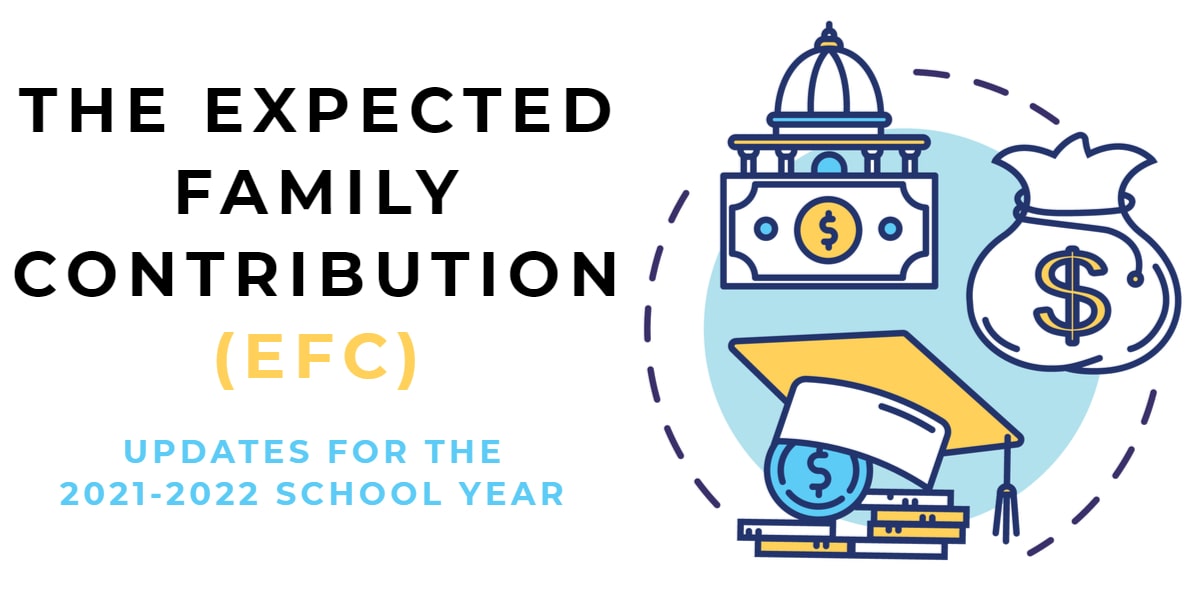THE EXPECTED FAMILY CONTRIBUTION (EFC) UPDATES FOR THE 2021-2022 SCHOOL YEAR

The Department of Education (DOE) recently announced the annual updates to the tables used in the statutory Federal Need Analysis Methodology that determines a student’s Expected Family Contribution (EFC) for the award year 2021-2022 for student financial aid programs.
The Higher Education Act requires the DOE to update these tables for price inflation annually:
- Income Protection Allowance (Student & Parents)
- Adjusted Net Worth (NW) of a Business or Farm
- Asset Protection Allowance
- EFC Assessment Rates
- Employment Expense Allowance
These updates are based, in general, upon increases in the Consumer Price Index (CPI). In developing the table values for the 2021-2022 school year, the Secretary assumed a 2.1 percent increase in the CPI.
INCOME PROTECTION ALLOWANCE
This allowance is the dollar amount of living expenses deducted from an individual or family’s income. The dollar offset varies by family size. The Income Protection Allowance for dependent students is $6,970.
The Income Protection Allowance for parents of dependent students for the 2021-22 school year are as follows:
PARENTS OF DEPENDENT STUDENTS
| Family size | Number in College | ||||
| 1 | 2 | 3 | 4 | 5 | |
| 2 | $19,440.00 | $16,110.00 | N/A | N/A | N/A |
| 3 | $24,200.00 | $20,900.00 | $17,570.00 | N/A | N/A |
| 4 | $29,890.00 | $26,570.00 | $23,260.00 | $19,930.00 | N/A |
| 5 | $35,270.00 | $31,940.00 | $28,640.00 | $25,310.00 | $22,000.00 |
| 6 | $41,250.00 | $37,930.00 | $34,620.00 | $31,300.00 | $27,990.00 |
For each additional family member add $4,660. For each additional college student subtract $3,310.
ADJUSTED NET WORTH OF A BUSINESS OR FARM
A percentage of the net worth (assets minus debts) of a business or farm is excluded from the calculation of an EFC because (1) the income produced from these assets is already assessed in another part of the computation; and (2) the formula protects a portion of the value of the assets. The dollar amount of these assets used in the following contribution calculation is for parents of dependent students.
| If the Net Worth (NW) of a business or farm is | Then the Adjusted Net Worth (NW) is |
| Less than $1 | $0.00 |
| $1 to $140,000 | 40% of net worth of business/farm |
| $140,001 to $415,000 | $56,000 + 50% of net worth over $140,000 |
| $415,001 to $695,000 | $193,500 + 60% of net worth over $415,000 |
| $695,001 or more | $361,500 + 100% of net worth over $695,000 |
ASSET PROTECTION ALLOWANCE
The Asset Protection Allowance protects a portion of net worth (assets minus debts) from being considered available for postsecondary educational expenses. The following is the asset protection allowance tables for parents of dependent students:
| AGE OF OLDEST PARENT | ASSET PROTECTION ALLOWANCE | |
| Married Parent | Single Parent | |
| 25 or less | $0.00 | $0.00 |
| 26 | $400.00 | $100.00 |
| 27 | $700.00 | $300.00 |
| 28 | $1,100.00 | $400.00 |
| 29 | $1,500.00 | $600.00 |
| 30 | $1,800.00 | $700.00 |
| 31 | $2,200.00 | $800.00 |
| 32 | $2,600.00 | $1,000.00 |
| 33 | $2,900.00 | $1,100.00 |
| 34 | $3,300.00 | $1,300.00 |
| 35 | $3,700.00 | $1,400.00 |
| 36 | $4,000.00 | $1,500.00 |
| 37 | $4,400.00 | $1,700.00 |
| 38 | $4,800.00 | $1,800.00 |
| 39 | $5,100.00 | $2,000.00 |
| 40 | $5,500.00 | $2,100.00 |
| 41 | $5,600.00 | $2,200.00 |
| 42 | $5,700.00 | $2,200.00 |
| 43 | $5,900.00 | $2,300.00 |
| 44 | $6,000.00 | $2,300.00 |
| 45 | $6,200.00 | $2,400.00 |
| 46 | $6,300.00 | $2,400.00 |
| 47 | $6,500.00 | $2,500.00 |
| 48 | $6,600.00 | $2,500.00 |
| 49 | $6,800.00 | $2,600.00 |
| 50 | $7,000.00 | $2,700.00 |
| 51 | $7,100.00 | $2,700.00 |
| 52 | $7,300.00 | $2,800.00 |
| 53 | $7,500.00 | $2,900.00 |
| 54 | $7,700.00 | $2,900.00 |
| 55 | $7,900.00 | $3,000.00 |
| 56 | $8,100.00 | $3,100.00 |
| 57 | $8,400.00 | $3,100.00 |
| 58 | $8,600.00 | $3,200.00 |
| 59 | $8,800.00 | $3,300.00 |
| 60 | $9,100.00 | $3,400.00 |
| 61 | $9,300.00 | $3,500.00 |
| 62 | $9,600.00 | $3,600.00 |
| 63 | $9,900.00 | $3,700.00 |
| 64 | $10,200.00 | $3,800.00 |
| 65 or older | $10,500.00 | $3,900.00 |
EXPECTED FAMILY CONTRIBUTION (EFC) ASSESSMENT RATES
The Expected Family Contribution (EFC) Assessment Rate Schedule is used to determine the EFC from family financial resources toward educational expenses. For dependent students, the EFC is derived from an assessment of the parent’s adjusted available income (AAI). The AAI represents a measure of a family’s financial strength, which considers both income and assets. The parents’ contribution for a dependent student is computed as follows:
| IF ADJUSTED AVAILABLE INCOME IS | THEN THE CONTRIBUTION IS |
| LLess than -$3,409 | -$750.00 |
| $-3,409 to $17,400 | 22% of AAI |
| $17,401 to $21,800 | $3,828 + 25% of AAI over $17,400 |
| $21,801 to $26,200 | $4,928 + 29% of AAI over $21,800 |
| $26,201 to $30,700 | $6,204 + 34% of AAI over $26,200 |
| $30,701 to $35,100 | $7,734 + 40% of AAI over $30,700 |
| $35,101 or more | $9,494 + 47% of AAI over $35,100 |
EMPLOYMENT EXPENSE ALLOWANCE
The allowance for employment-related expenses for the parents of dependent students recognizes the additional costs incurred by working spouses and single-parent households. This allowance is calculated based on the marginal differences in expenditures for a two-worker family compared to a one worker family. The items covered by these additional expenses are:
- Food costs away from home,
- Apparel,
- Transportation,
- Household furnishings and operations.
The employment expense allowance for parents of dependent students is the lesser of $4,000, or 35 percent of earned income of the lowest-earning spouse.
The Expected Family Contribution (EFC) is a number that determines students’ eligibility for federal student aid. The EFC formulas use the financial information that parents and students provide on their Free Application for Federal Student Aid (FAFSA) to calculate the EFC. Financial aid administrators (FAAs) subtract the EFC from students’ cost of attendance (COA) to determine their need for financial aid.
THE EDUCATION LOAN RATE UPDATES FOR THE 2021-2022 SCHOOL YEAR
The Department of Education also announced the new federal student loan interest rates for 2019-2020. For the first time in three years, interest rates on federal student loans will decrease.
| LOAN TYPE | 2019-2020 | 2020-2021 |
| Direct Subsidized and Unsubsidized Loans | 4.53% | 2.75% |
| Graduate Direct Subsidized and Unsubsidized Loans | 6.08% | 4.30% |
| Parent (PLUS) Loans | 7.08% | 5.30% |
Posted by Ron Them
He is a former Chief Financial Officer of a Fortune 500 company and currently owns his own financial advisory company specializing in cash flow planning for business owners and executives. He developed the Cash Flow Recovery™ process that uses cash flow management principals to increase asset value and build wealth for business owners.
He is also the originator of several software calculators to help advisors and families make college affordable, including:
* College QuikPlan EFC Calculator
* "Find the Money" College Cash Flow Calculator
* College Debt Reduction Calculator
Ron has been quoted in U.S. News and World Report, Kiplinger's Personal Finance, Smart Money, Financial Advisor Magazine, Small Firm Profit Report, Practical Accountant, LIMRA's Market Facts, Senior Advisors Magazine, HR Magazine, BenefitNews.com, Employee Benefit News Magazine, ProducersWeb.com, Entrepreneur Magazine, Insurance Selling Magazine, CollegeNews.com, The Christian Voice, and Columbus CEO Magazine.
